
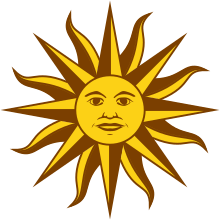
The Sun of May (Sol de Mayo) is a national symbol of Argentina and Uruguay, appearing on both of their flags.


The Sun of May (Sol de Mayo) is a national symbol of Argentina and Uruguay, appearing on both of their flags.
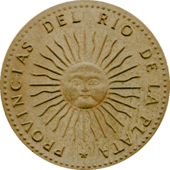
According to Diego Abad de Santillán, the Sun of May represents Inti, the Incan god of the sun. [1]
The specification "of May" is a reference to the May Revolution which took place in the week from 18 to 25 May 1810, which marked the beginning of the independence from the Spanish Empire for the countries that were then part of the Viceroyalty of the Río de la Plata. A legend claims that as the new government was proclaimed, the sun broke through the clouds, which was seen as a good omen.
In the flag of Argentina, the Sun of May is the radiant golden yellow sun bearing the human face and thirty-two rays that alternate between sixteen straight and sixteen wavy.
In the flag of Uruguay, the Sun of May is the golden yellow sun bearing the human face and sixteen triangular rays that alternate between eight straight and eight wavy.
Inspired by the Latin American wars of independence, the Philippines, which was a fellow former Spanish colony, also adopted the Sun of May as a revolutionary banner. This later became a faceless sun symbol in the current national flag.
The sun, called the Sun of May, is a replica of an engraving on the first Argentine coin, approved in 1813 by the Constituent Assembly, whose value was eight escudos (a Spanish currency denomination).
In form, it is similar to—and may be partially derived from—the sun in splendour, which is common in European heraldry. This, too, is usually depicted with a face, and with alternating straight and wavy rays (representing light and heat respectively), [2] though it normally has only sixteen rays.
A 1978 law describing the official ceremonial flag of Argentina specifies that the sun must be golden yellow in color (amarillo oro), have an inner diameter of 10 cm, and an outer diameter of 25 cm (the diameter of the sun equals 5⁄6 the height of the white stripe, and the sun's face is 2⁄5 of its height), must feature 32 rays (16 undulated and 16 straight in alternation), [3] and must be embroidered in the official ceremonial flag.

The national flag of the Philippines is a horizontal bicolor flag with equal bands of royal blue and crimson red, with a white, equilateral triangle at the hoist. In the center of the triangle is a golden-yellow sun with eight primary rays, each representing a province. At each vertex of the triangle is a five-pointed, golden-yellow star, each of which representing one of the country's three main island groups—Luzon, Visayas, and Mindanao. The white triangle at the hoist represents liberty, equality, and fraternity. A unique feature of this flag is its usage to indicate a state of war if it is displayed with the red side on top, which is effectively achieved by flipping the flag upside-down.

José Francisco de San Martín y Matorras, known simply as José de San Martín or "the Liberator of Argentina, Chile and Peru", was an Argentine general and the primary leader of the southern and central parts of South America's successful struggle for independence from the Spanish Empire who served as the Protector of Peru. Born in Yapeyú, Corrientes, in modern-day Argentina, he left the Viceroyalty of the Río de la Plata at the early age of seven to study in Málaga, Spain.

The national flag of the Argentine Republic, often referred to as the Argentine flag, is a triband, composed of three equally wide horizontal bands coloured light blue and white. There are multiple interpretations on the reasons for those colors. The flag was created by Manuel Belgrano, in line with the creation of the Cockade of Argentina, and was first raised at the city of Rosario on February 27, 1812, during the Argentine War of Independence. The National Flag Memorial was later built on the site. The First Triumvirate did not approve the use of the flag, but the Asamblea del Año XIII allowed the use of the flag as a war flag. It was the Congress of Tucumán which finally designated it as the national flag, in 1816. A yellow Sun of May was added to the center in 1818.
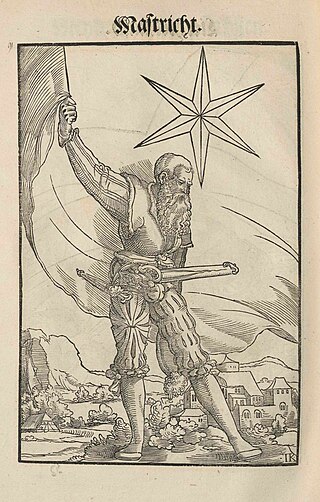
In heraldry, the term star may refer to any star-shaped charge with any number of rays, which may appear straight or wavy, and may or may not be pierced. While there has been much confusion between the two due to their similar shape, a star with straight-sided rays is usually called a mullet in English heraldry while one with wavy rays is usually called an estoile.

A solar symbol is a symbol representing the Sun. Common solar symbols include circles, crosses, and spirals. In religious iconography, personifications of the Sun or solar attributes are often indicated by means of a halo or a radiate crown.

The flag of Peru was adopted by the government of Peru in 1825, and modified in 1950. According to the article 49 of the Constitution of Peru, it is a vertical triband with red outer bands and a single white middle band. Depending on its use, it may be defaced with different emblems, and has different names. Flag day in Peru is celebrated on 7 June, the anniversary of the Battle of Arica.

The national flag of Uruguay is one of the three official flags of Uruguay along with the flag of Artigas and the flag of the Treinta y Tres. It has a field of nine equal horizontal stripes alternating white and blue. The canton is white, charged with the Sun of May, from which 16 rays extend, alternating between triangular and wavy. The flag was first adopted by law on 18 December 1828, and had 19 alternating stripes of white and blue until 11 July 1830, when a new law reduced the number of alternating stripes to nine. The flag was designed by Joaquín Suárez.

The Viceroyalty of the Río de la Plata meaning "River of the Silver", also called "Viceroyalty of the River Plate" in some scholarly writings, in southern South America, was the last to be organized and also the shortest-lived of the Viceroyalties of the Spanish Empire in the Americas. The name "Provincias del Río de la Plata" was formally adopted in 1810 during the Cortes of Cádiz to designate the Viceroyalty of the Río de la Plata.

The seal of the president of the Philippines is a symbol used to represent the history and dignity of the president of the Philippines. Its original form was designed by Captain Galo B. Ocampo, secretary of the Philippine Heraldry Committee, and patterned after the seal of the president of the United States. It was first used by President Manuel Roxas in 1947.

The coat of arms of Uruguay or Uruguayan shield was first adopted by law on March 19, 1829, and later on had some minor modification in 1906 and 1908. It was supposedly designed by Juan Manuel Besnes Irigoyen (1788–1865).
The sol is the currency of Peru; it is subdivided into 100 céntimos ("cents"). The ISO 4217 currency code is PEN.
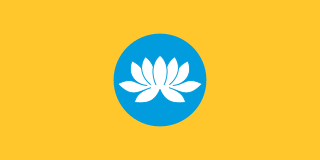
The flag of Kalmykia consists of a yellow field with a sky blue circle in the center containing a lotus. The yellow stands for the sun, the people and the religious faith of the nation. The blue represents the sky, eternity, and steadiness. The lotus is a symbol of purity, spiritual rebirth and happiness. Its five upper petals represent the continents and the lower four stand for the quarters of the globe. Together, they symbolize the will of the Kalmyks to live in friendship and to cooperate with all the nations of the world.
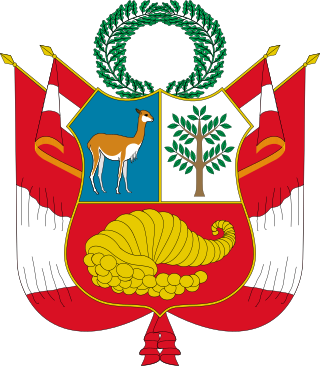
The Coat of arms of Peru is the national symbolic emblem of Peru. Four variants are used: the Coat of arms per se ; the National Coat of arms, or National Shield ; the Great Seal of the State ; and the Naval Coat of arms.

Inti is the ancient Inca sun god. He is revered as the national patron of the Inca state. Although most consider Inti the sun god, he is more appropriately viewed as a cluster of solar aspects, since the Inca divided his identity according to the stages of the sun. Worshiped as a patron deity of the Inca Empire, Pachacuti is often linked to the origin and expansion of the Inca Sun Cult. The most common belief was that Inti was born of Viracocha, who had many titles, chief among them being the God of Creation.

The official flag of Cusco has seven horizontal stripes of color: red, orange, yellow, green, sky blue, blue, and violet. This rainbow flag was introduced to Peru in 1973 by Raúl Montesinos Espejo, in recognition of the 25th anniversary of his Tawantinsuyo Radio station. As the flag's popularity grew, Cusco mayor Gilberto Muñiz Caparó declared it an official emblem in 1978. Since 2021, the official flag has also featured the golden Echenique's sun.

A representation of the sun is used as a heraldic charge. The most usual form, often called sun in splendour or in his glory, consists of a round disc with the features of a human face surrounded by twelve or sixteen rays alternating wavy and straight. The alternating straight and wavy rays are often said to represent the light and heat of the sun respectively.

The Cry of Asencio or Admirable alarm was an 1811 pronunciamiento that took place at the Banda Oriental against the Spanish rule in Montevideo. Made in support of Buenos Aires, which had already ousted the viceroy and established a local government during the May Revolution, it is considered the beginning of the Oriental revolution.

Sky blue is a shade of light blue comparable to that of a clear daytime sky. The term is attested from 1681. A 1585 translation of Nicolas de Nicolay's 1576 Les navigations, peregrinations et voyages faicts en la Turquie includes "the tulbant [turban] of the merchant must be skie coloured".

Argentina has a number of national symbols, some of which are extensively defined by law.
Es un sol figurado con rostro humano, de color oro amarillo con treinta y dos rayos: 16 flamígeros apuntando o "girando" en sentido horario, y 16 rectos colocados alternativamente, según diseño de la primera moneda argentina.
![]() Media related to Sun of May at Wikimedia Commons
Media related to Sun of May at Wikimedia Commons